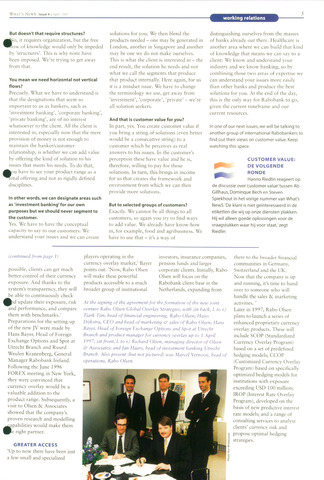m RONDE
WHAT'S NewS Issue 4 April 1997
working relations
5
But doesn't that require structures?
MÈJo, it requires organization, but the free
™ow of knowledge would only be impeded
by 'structures'. This is why none have
been imposed. We're trying to get away
from that.
You mean we need horizontal not vertical
flows?
Precisely. What we have to understand is
that the designations that seem so
important to us as bankers, such as
'investment banking', 'corporate banking',
'private banking', are of no interest
whatsoever to the cliënt. All the cliënt is
interested in, especially now that the mere
provision of money is not enough to
maintain the banker/customer
relationship, is whether we can add value
by offering the kind of solution to his
issues that meets his needs. To do that,
•jou have to see your product range as a
otal offering and not as rigidly defined
disciplines.
In other words, we can designate areas such
as 'investment banking'for our own
purposes but we should never segment to
the customer.
Yes. We have to have the conceptual
capacity to say to our customers: We
understand your issues and we can create
solutions for you. We then blend the
products needed - one may be generated in
London, another in Singapore and another
may be one we do not make ourselves.
This is what the cliënt is interested in - the
end result, the solution he needs and not
what we call the segments that produce
that product internally. Here again, for us
it is a mindset issue. We have to change
the terminology we use, get away from
'investment', 'corporate', 'private' - we're
all solution seekers.
And that is customer value for you?
In part, yes. You create customer value if
you bring a string of solutions (even better
would be a consecutive string) to a
customer which he perceives as real
answers to his issues. In the customer's
perception these have value and he is,
therefore, willing to pay for those
solutions. In turn, this brings in income
for us that creates the framework and
environment from which we can then
provide more solutions.
But to selected groups of customers?
Exactly. We cannot be all things to all
customers, so again you try to find ways
to add value. We already have know-how
in, for example, food and agribusiness. We
have to use that - it's a way of
distinguishing ourselves from the masses
of banks already out there. Healthcare is
another area where we can build that kind
of knowledge that means we can say to a
dient: We know and understand your
industry and we know banking, so by
combining those two areas of expertise we
can understand your issues more easily
than other banks and produce the best
solutions for you. At the end of the day,
this is the only way for Rabobank to go,
given the current timeframe and our
current resources.
In one of our next issues, we will be talking to
another group of international Rabobankers to
find out their views on customer value. Keep
watching this space.
CUSTOMER VALUE:
DE VOLGENDE
Hanno Riedlin reageert op
de discussie over'customer value'tussen Ab
Gillhaus, Dominque Bech en Steven
Spiekhout in het vorige nummer van What's
NewS.'De klant is niet geïnteresseerd in de
etiketten die wij op onze diensten plakken.
Hij wil alleen goede oplossingen voor de
vraagstukken waar hij voor staat,'zegt
Riedlin
there to the broader financial
communities in Germany,
Switzerland and the UK.
Now that the company is up
and running, it's time to hand
over to someone who will
handle the sales marketing
activities.
Later in 1997, Rabo Olsen
plans to launch a series of
enhanced proprietary currency
overlay products. These will
include SCOP (Standardized
Currency Overlay Program)
based on a set of predefined
hedging models; CCOP
(Customized Currency Overlay
Program) based on specifically
optimized hedging models for
institutions with exposure
exceeding USD 100 million;
IROP (Interest Rate Overlay
Program), developed on the
basis of new predictive interest
rate models; and a range of
consulting services to analyse
clients' currency risk and
propose optimal hedging
strategies.
(continued from page 1)
possible, clients can get much
better control of their currency
exposure. And thanks to the
system's transparency, they will
be able to continuously check
^td update their exposure, risk
and performance, and compare
them with benchmarks.'
Preparations for the setting-up
of the new JV were made by
Hans Bayer, Head of Foreign
Exchange Options and Spot at
Utrecht Branch and Ruurd
Weulen Kranenberg, General
Manager Rabobank Ireland.
Following the June 1996
FOREX meeting in New York,
they were convinced that
currency overlay would be a
valuable addition to the
product range. Subsequently, a
visit to Olsen Associates
showed that the company's
proven research and modelling
•tpabilities would make them
Ie right partner.
GREATER ACCESS
'Up to now there have been just
a few small and specialized
players operating in the
currency overlay market,' Bayer
points out. 'Now, Rabo Olsen
will make these powerful
products accessible to a much
broader group of institutional
investors, insurance companies,
pension funds and larger
corporate clients. Initially, Rabo
Olsen will focus on the
Rabobank dient base in the
Netherlands, expanding from
At the signing of the agreement for the formation of the neu> joint
venture Rabo Olsen Global Overlay Strategies, with (in backl. to r.)
Tjark Tjin, head of financial engineering, Rabo Olsen; Haijo
Dijkstra, CEO and head of marketing sales of Rabo Olsen; Hans
Bayer, Head of Foreign Exchange Options and Spot at Utrecht
Branch and product manager for currency overlay up to 1 April
1997; (at front, l. to r.) Richard Olsen, managing director of Olsen
Associates; and Jan Haars, head of investment banking Utrecht
Branch. Also present (but not pictured) was Marcel Vernooij, head of
operations, Rabo Olsen.

